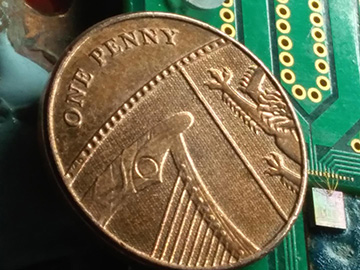
A chip-based device with an area of roughly 1 mm2 can potentially generate quantum-based random numbers at gigabit-per-second speeds. The small square to the right of the penny contains all the optical components of the random number generator. [Image: Francesco Raffaelli / University of Bristol]
Generating random numbers from photon emission, rather than computational algorithms, could become one basis for rock-solid encryption technologies. A team based at a British university has developed a tiny, low-power silicon-photonics chip that generates quantum random numbers at rates of gigabits per second (Opt. Express, doi:10.1364/OE.26.019730).
From optical to electrical fluctuations
The group, based in the University of Bristol, placed the optical components on a silicon-on-insulator chip, about 1 mm2 in total area. The chip's tiny waveguides directed light from an external diode laser through a cascade of three Mach-Zehnder interferometers. The central interferometer, unbalanced with a delay line, converted phase fluctuations into intensity fluctuations. The output from the cascade was fed into two photodiodes, one to monitor and calibrate the interferometers and the other to convert the optical intensity fluctuations into voltage fluctuations.
Previously, the study’s lead author, Bristol doctoral candidate Francesco Raffaelli, and his colleagues had integrated an optical homodyne detector onto a chip and used it to generate quantum random numbers, among other tasks (Quantum Sci. Technol., doi: 10.1088/2058-9565/aaa38f). However, Raffaelli says, the two chips exploit different physical effects.
The more recent device generated a larger electrical random signal—from the same amount of optical power injected into the chip—than the previous experiment. The stronger signal means that the electronics in the chip can process faster. The researchers estimate that their chip could generate random numbers at up to 2.8 Gbps—which could provide real-time encryption.
Speed and optical loss
In both cases, the proof-of-concept chips were not perfectly optimized for speed, Raffaelli says. He believes that the latest experiment could be tweaked to approach state-of-the-art random-number generation rates above 10 Gbps, which are now possible only with bulk fiber optics and related components.
To deal with the partial scattering and absorption of light within the chip, which induces losses of optical power and slows down the generation of random numbers, the Bristol team had to carefully control the photonic chip's operating parameters. “Moreover, the optical losses mean that the electrical signal generated when the light is detected is very small,” Raffaelli says. “Therefore another issue is to design control electronics that must be at the same time very fast and very sensitive, which is not a trivial task.”
Although the chip looks small enough to fit into today's handheld devices, Raffaelli says that the device still requires external control electronics that are not as compact. With further engineering, he adds, the technology could be used in a standalone source of high-rate random numbers. Such practical considerations will drive the team's next round of research.
